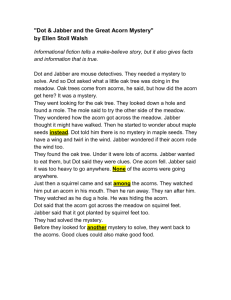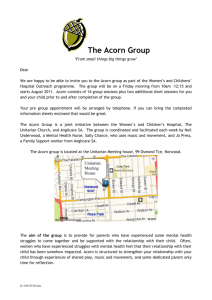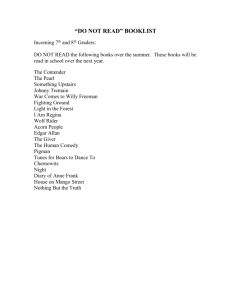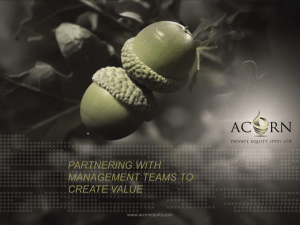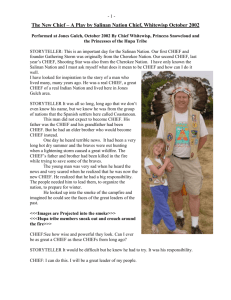ECI-02_Acorn_Grindin..
advertisement
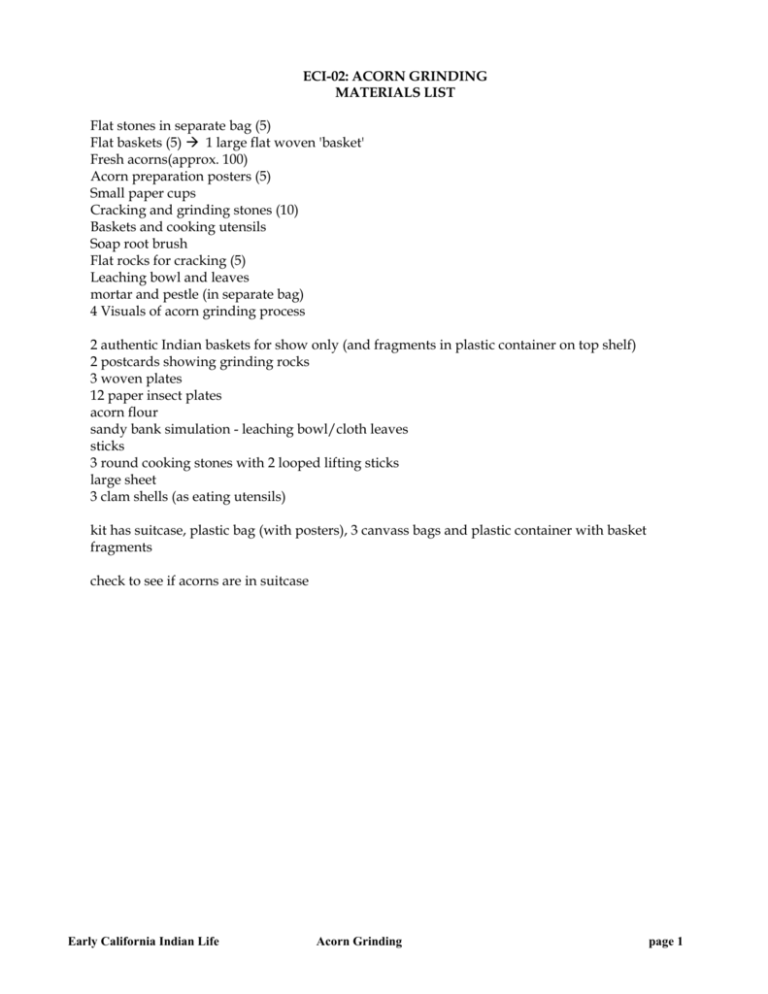
ECI-02: ACORN GRINDING MATERIALS LIST Flat stones in separate bag (5) Flat baskets (5) 1 large flat woven 'basket' Fresh acorns(approx. 100) Acorn preparation posters (5) Small paper cups Cracking and grinding stones (10) Baskets and cooking utensils Soap root brush Flat rocks for cracking (5) Leaching bowl and leaves mortar and pestle (in separate bag) 4 Visuals of acorn grinding process 2 authentic Indian baskets for show only (and fragments in plastic container on top shelf) 2 postcards showing grinding rocks 3 woven plates 12 paper insect plates acorn flour sandy bank simulation - leaching bowl/cloth leaves sticks 3 round cooking stones with 2 looped lifting sticks large sheet 3 clam shells (as eating utensils) kit has suitcase, plastic bag (with posters), 3 canvass bags and plastic container with basket fragments check to see if acorns are in suitcase Early California Indian Life Acorn Grinding page 1 ACORN GRINDING ECI - 2 SOURCE: Janis Freestone update: aug 2004 OBJECTIVE: To prepare acorn meal by cracking, opening and grinding dried acorns and to demonstrate how the California Indians used this abundant local food source. SCIENCE THEMES: Scale and structure, systems and interactions PROCESS SKILLS: Observing, relating, applying, ordering GRADE LEVELS: 3-5 FOCUS WORDS: Acorns, leaching, grinding, mortar, pestle, meal, food staple BACKGROUND INFORMATION: The California Indians used acorn meal in their daily diet. Acorns sustained their lives and were a nutritious, abundant and reliable food source. Because the acorn was a significant part of their life, the oak tree held a special spiritual meaning, symbolizing fertility, strength and oneness with the earth. Each new acorn harvest was celebrated with acorn falling ceremonies. Acorns were gathered every fall with the new harvest. Indian families would retreat to the oak forests for days and weeks to gather acorns for use through-out the next year. The men and boys would assist in gathering by shaking or poking the acorns free of the great oak branches. The women and children would gather between 100-200 lbs. of acorns for each person in the family. This gathering took many days, and some acorn grinding and cooking would take place right at this site. Acorns were then carried back to the villages in large conical baskets and dried in the sun or over a fire for several days. After drying, they were stored in woven basket granaries to prevent damage from weather and animals. Acorns were removed from the granary as needed for grinding and cooking mush soup and flat bread for the family. The acorn was first cracked by placing the point down on a flat rock while hammering a second rock on the opposite end. After this the shell could be easily removed by hand. When necessary, the skins of some acorns were removed by rubbing the nut against a winnowing basket. After cracking and removing the acorn husks, the whole nut meats were placed in a stone mortar or depression in a large "Indian rock"and ground into a fine meal with a stone or piece of hardwood that resembled a pestle. After grinding, the fine meal was separated from the coarse using a flat basket as a sifter. Early California Indian Life Acorn Grinding page 2 BACKGROUND INFORMATION: (continued) The acorn meal was leached for one to two hours by placing it in a hand made sandy depression in the side of a creek. This depression was lined with leaves and acted as a small basin to which water could be added several times This sieve would remove the unpleasant flavor of tannic acid from the acorn meat. The product was transferred to a basket with extra water and cooked with hot rocks, transferred with sticks, from the fire. The soup or mush was carefully stirred as hot rocks were added. This continued until the soup was boiling and finally reached the desired thickness. Leached acorn meal was also used to make a cake or bread by wrapping it in wet leaves and placing it on rocks in the fire to bake. This wonderfully sweet food would become very hard after a few days and would last for months. John Muir carried this bread on his travels through the Sierras and claimed it was the most compact and strength giving food he had ever eaten. The California Indians used all regional oaks , the coast live oak, black oak and tan oak, as their source of acorns, but had preferences based on taste, ease of preparation and abundance. Acorns were sometimes used in trade because of these preferences. Set up Procedures This station should be set up outside, whenever possible, to reduce clean-up. Set up 4 or 5 work stations (2 students at each); one grinding rock in a flat basket, with one pestle rock and one board for cracking acorns with one cracking rock. The children will have to share the one soap root brush to brush acorn flour into the cup. Set up the "sandy bank bowl" and line it with leaves for the leaching demonstration. Display the cooking (baskets and sticks) and eating utensils(clam shells). Display the posters. Suggested Introduction: (5 minutes) California Indians have lived in the Santa Clara Valley for many thousands of years. In the past, they did not have any of the modern conveniences we have today to help in their daily lives. They lived in harmony with the environment and their lives depended on all life around them. At this station you will learn how to prepare a very important food, considered a staple in the California Indian diet, the acorn. Can anyone in the group describe an acorn? What is a nut? Describe some different kinds of nuts. Can anyone tell me from what kind of tree an acorn comes ? Close your eyes for a minute, picture the large oak trees you see growing all around this area, with your eyes still closed can you describe an oak tree? What time of the year are acorns found on the ground or in the tree? Early California Indian Life Acorn Grinding page 3 What do you think the Native Americans used the acorns for? What is a food staple? What is a food staple in your diet? Early California Indian Life Acorn Grinding page 4 ACTIVITY: (10 minutes) 1. Tell the story of the acorn (described in the background information) from gathering, to eating. Use the five posters found in this station. As you tell the story, show acorns, baskets, mortar and pestle, soap root brush and cooking and eating utensils to the children. Do not allow the children to handle these items until you are ready to have them do the acorn grinding. 2. Demonstrate acorn cracking and grinding and the use of the soap root brush to brush acorn meal into paper cups. Demonstrate leaching with the pretend "sandy bank" and the leaves. You may also demonstrate the use of the cooking rocks by picking them up with the sticks and placing them in the basket and stirring the "invisible " mush slowly. 3. Separate children into 5 groups of two and instruct the children that one child will crack acorns while the other grinds. Inform them that they will switch activities after a few minutes. You may want to crack a few acorns the night before so the grinders have something to start grinding. This is not essential as the crackers usually produce acorns quickly. 4. Let children begin and assist them if necessary While they are grinding, share further facts about acorns, the California Indian’s respect for the environment and the philosophy of living for the seventh generation. Ask them how they show respect for the environment. Allow 5-7 minutes for the children to crack and grind acorns. 5. Ask the children to save their ground meal in the paper cup and later, after the EVs have left, the class can prepare acorn soup together with their teacher’s help. 6. Give the cup of acorn meal to the teacher before you leave the classroom. CONCLUSION: (5 minutes) These questions are intended to reinforce the concepts of stewardship and dependency on the environment for survival. Ask the students what they think California Indians did if they could not find enough acorns? The Indians used different food sources such as the bay, black walnut and hazelnut and buck- eye (only as a last resort, when other nuts weren’t available). Acorns were the main staple of the Indians’ diet, because they were a readily available food that provided substantial bulk and nutrition. What do we eat that might be similar to acorn meal? Porridge, rice, pasta, mashed potatoes, bread, tortillas, poi. Think about how the California Indians felt about their environment and especially the oak tree. What do the students think these ancient Native Americans did to insure an available supply of acorns? Indians did practice horticultural techniques. That is, they used methods to enhance the growth of plants that they made frequent use of. They also maintained specific trees and other plants that were considered the property of their family or tribe. The Indians celebrated the Oak Tree. Ask the students if they have a special tree or plant? Early California Indian Life Acorn Grinding page 5 RESOURCES: See EVs Guide - Early California Indians: An Environmental Focus for a complete list of resources. Bruce M. Pavlik, C. Muick, Sharon Johnson, Majorie Popper, Oaks of California, Cachuma Press, Inc., CA 1991. Early California Indian Life Acorn Grinding page 6

